Job Descriptions Ownership and Writing Policy Template
1. Purpose and Scope
This policy establishes clear guidelines for the creation, ownership, maintenance, and approval of job descriptions across the organization. It ensures consistency, accuracy, and compliance while defining roles and responsibilities in the job description development process.
2. Policy Statement
All positions within the organization must have a current, accurate job description that reflects the essential functions, qualifications, and requirements of the role. Job descriptions serve as foundational documents for recruitment, performance management, compensation, and organizational planning.
3. Ownership and Responsibilities
3.1 Human Resources Department
Maintains the central repository of all job descriptions
Ensures compliance with legal and regulatory requirements
Provides templates, guidelines, and training for job description creation
Conducts periodic audits to ensure accuracy and currency
Facilitates the review and approval process
3.2 Department Managers/Supervisors
Initiate job description creation for new positions
Draft or update job descriptions for positions within their department
Ensure accuracy of role responsibilities, qualifications, and reporting relationships
Submit job descriptions for review and approval
Notify HR of significant changes to existing positions
3.3 Senior Leadership/Department Heads
Review and approve job descriptions within their area of responsibility
Ensure alignment with departmental goals and organizational strategy
Authorize changes to reporting structures and position levels
3.4 Compensation/Total Rewards Team
Review job descriptions for appropriate classification and grade level
Ensure internal equity and market competitiveness
Provide guidance on FLSA (Fair Labor Standards Act) classification where applicable
4. Job Description Development Process
4.1 Creating New Job Descriptions
Manager identifies need for new position and completes workforce planning approval
Manager drafts job description using HR-provided template
Manager submits draft to HR for initial review
HR reviews for compliance, clarity, and consistency
Compensation reviews for appropriate classification
Department Head provides final approval
HR publishes approved version in central repository
4.2 Updating Existing Job Descriptions
Job descriptions should be reviewed and updated when:
Significant changes occur to role responsibilities (typically 25% or more)
Reporting relationships change
Required qualifications or competencies evolve
Position is vacant and being recruited
During organizational restructuring
At minimum, every three years
4.3 Approval Authority
Position LevelApproval RequiredIndividual ContributorDepartment Manager + HRSupervisor/Team LeadDepartment Head + HR + CompensationManagerSenior Leadership + HR + CompensationDirector and aboveExecutive Leadership + HR + Compensation
5. Job Description Standards
5.1 Required Components
All job descriptions must include:
Job title
Department and reporting relationship
Position summary/objective
Essential duties and responsibilities
Required qualifications (education, experience, certifications)
Preferred qualifications
Key competencies and skills
Physical demands and work environment (if applicable)
FLSA classification (Exempt/Non-exempt)
Date of last revision
5.2 Writing Guidelines
Use clear, concise language
Begin duty statements with action verbs
Focus on outcomes and impact, not just tasks
Distinguish between essential and marginal functions
Avoid discriminatory language or unnecessary requirements
Ensure consistency with similar roles across the organization
Include percentage of time or priority indicators for major responsibilities
6. Compliance Requirements
6.1 Legal Compliance
All job descriptions must:
Comply with employment laws including ADA, FLSA, and EEO regulations
Accurately reflect essential functions for ADA purposes
Avoid requirements that could create discriminatory barriers
Be reviewed by legal counsel when necessary
6.2 ADA Considerations
Clearly identify essential versus marginal job functions
Describe physical demands and work environment accurately
Focus on outcomes rather than methods of accomplishment
Include reasonable accommodation statement
7. Storage and Access
7.1 Central Repository
HR maintains the official repository of all approved job descriptions
Only current, approved versions are stored in the system
Previous versions are archived with revision history
7.2 Access and Distribution
Managers have access to job descriptions for their department
Employees can request copies of their own job descriptions
Recruiting team has access for hiring purposes
Confidential compensation information is restricted
8. Training and Support
HR provides:
Job description writing workshops for managers
Templates and sample descriptions
One-on-one consultation for complex positions
Guidelines and reference materials
Regular updates on compliance requirements
9. Policy Review
This policy will be reviewed annually or as needed to ensure continued effectiveness and compliance with changing regulations.
10. Related Policies
Recruitment and Selection Policy
Performance Management Policy
Compensation Philosophy and Structure
Organizational Change Management Policy
Policy Effective Date: [Insert Date]
Last Reviewed: [Insert Date]
Next Review Date: [Insert Date]
Policy Owner: Human Resources Department
Approved By: [Title/Name]RetryClaude can make mistakes. Please double-check responses.
Job Descriptions Ownership and Writing Policy Template
Job Descriptions Ownership and Writing Policy
1. PURPOSE
Explain the content and rationale of the Job Descriptions, the development procedure for the roles and responsibilities, functions of the various jobs, and specifically, the OHS responsibilities.
The ownership and responsibilities for updating the job descriptions is established.
Specifically, within this document, the requirements and obligations of individuals responsible to develop their roles is outlined.
2. POLICY
2.1 Job descriptions are written for all jobs; some job descriptions are summarized if tasks are at least 80% the same.
2.2 Job Descriptions are updated every year at the annual performance appraisal cycle; in any case they are reviewed, staff and HOD consult and discuss with each other/the team, and master copies are signed every three years (admin cycle). The ownership of the job description and the responsibility for updating the job description lies with the manager of the department. The department head needs to sign off the final version of the job description. HR keeps a signed copy in the personnel file. Department Head is responsible to keep HR department updated of changes and to provide a copy of the updated signed version. JD can be shown to personnel at all times, but no copies are given out in order to keep version controlled with in the departments.
2.3 All job descriptions include mandatory responsibilities for contribution to the system. Specific roles within the system: Quality, Risk management, Fire, Safety and Security officers, Facilities management, incident reporting, action planning risk identification and mitigation, Infection control all contain competencies and certifications, and performance target objectives as required.
3. PROCEDURE:
3.1. Title of the job and department of the job is defined in the Header of the document. The footer of the document has the page numbering in the format “page x of xx”. Footer also has the path and file where the file can be found. Additionally, header contains information regarding tem leaders (# of subordinate staff), and to whom the job owner reports
3.2. Job Purpose of the job description is described and defined as a summary of the main tasks of the position
3.3. The job description is divided in the following chapters:
3.3.1. Job purpose
3.3.2. Duties and responsibilities
3.3.3. Primary responsibilities (80%); include specific functions and specific KPIs, and performance target measures
3.3.4. Operations
Customer Service
Business Management
Staff Management
Communication
Secondary responsibilities (standardized for all staff)
Personal responsibilities: includes reasonable care for their own and colleagues’ Health, safety and well being, and awareness and contribution to care of the environment
Job Requirements
Skills and Knowledge: competency framework requirements, includes training
Personal traits
Educational Qualifications
3.4 Every Primary Responsibility has a Key Performance Measure defined. Elements within job roles have specific outcome performance measures defined. (Using SMART objectives defined)
3.5 The Key Performance Measure is linked to the overall department and Clinic goals as defined by Management, and as required by the company
3.6 All tasks of the job are defined and text can be used to recruit new or replacement personnel for the particular function. All tasks of the job outlined that need competency assessments are itemized on the orientation document for that particular department.
3.7 All text is to be in Ariel 12 pt. and in the format of the template attached
3.8 All changes approved, and submitted to HR for final formatting and leadership approval.
5. ATTACHMENTS
What is a Job Descriptions Ownership and Writing Policy?
A Job Descriptions Ownership and Writing Policy is a formal organizational document that establishes clear guidelines, responsibilities, and procedures for creating, maintaining, and updating job descriptions across the company. This policy defines who has the authority to draft, review, approve, and modify job descriptions, ensuring consistency, accuracy, and legal compliance throughout the organization.
Why Do You Need a Job Descriptions Ownership and Writing Policy?
- Ensures consistency in how roles are documented across all departments
- Establishes clear accountability for creating and maintaining job descriptions
- Reduces legal risks by ensuring compliance with employment laws and regulations
- Facilitates fair compensation structures by standardizing job documentation
- Supports recruitment efforts with accurate, professional job postings
- Enables better performance management through clear role expectations
- Prevents disputes over job responsibilities and reporting structures
- Streamlines organizational planning and workforce analysis
- Maintains up-to-date documentation as roles evolve
Who Should Create and Enforce This Policy?
- Human Resources Department: Primary owners responsible for policy development, implementation, and enforcement
- Senior Leadership/Executive Team: Provides strategic direction and final approval authority
- Legal/Compliance Team: Reviews policy for legal compliance and risk mitigation
- Department Heads: Collaborate on departmental-specific requirements and role definitions
- Hiring Managers: Provide input on technical requirements and role specifications
- Compensation and Benefits Team: Ensures alignment with salary structures and classifications
When Should This Policy Be Implemented or Updated?
- During organizational restructuring or significant growth phases
- When establishing a new company or formalizing HR processes
- After legal or regulatory changes affecting employment documentation
- Following audit findings or compliance issues related to job descriptions
- When implementing new HRIS or talent management systems
- After merger or acquisition activities
- When standardizing processes across multiple locations or divisions
- In response to employee disputes over role responsibilities
- During periodic policy review cycles (typically annually or biannually)
Elements and Structure of the Policy Document
- Policy Statement: Clear declaration of purpose and scope
- Definitions: Key terms like "job description," "ownership," "approval authority"
- Roles and Responsibilities: Detailed accountability matrix for all stakeholders
- Writing Standards: Format, length, language requirements, and templates
- Approval Workflow: Step-by-step process from draft to final approval
- Review Schedule: Mandatory review intervals and triggers for updates
- Compliance Requirements: Legal and regulatory considerations
- Storage and Access: Where descriptions are maintained and who can access them
- Exceptions Process: How to handle non-standard situations
- Enforcement and Consequences: What happens when policy is not followed
Policy Implementation Announcement Email
Subject: New Job Descriptions Ownership and Writing Policy - Effective [Date]
Dear Team,
I am writing to announce the implementation of our new Job Descriptions Ownership and Writing Policy, effective [date]. This policy establishes clear guidelines for creating, reviewing, and maintaining job descriptions across our organization.
The policy aims to ensure consistency, legal compliance, and accuracy in how we document roles and responsibilities. All current job descriptions will be reviewed and updated according to the new standards within the next [timeframe].
Key highlights of the policy include:
- Designated ownership responsibilities for HR, department heads, and hiring managers
- Standardized templates and writing guidelines
- Clear approval workflows requiring HR and management sign-off
- Mandatory annual reviews of all job descriptions
The complete policy document is available on our intranet under HR Policies. All managers are required to review the policy by [deadline] and attend a training session scheduled for [date/time].
Your cooperation in implementing this policy will help us maintain professional, accurate, and legally compliant job documentation.
Please contact the HR department if you have any questions.
Best regards,
[Your Name]
[Title]
[Contact Information]
Request for Job Description Review and Update Letter
Subject: Action Required: Review and Update Job Description for [Position]
Dear [Manager Name],
As part of our annual job description review process outlined in our Job Descriptions Ownership and Writing Policy, we are requesting your review and update of the job description for [Position Title] in your department.
The current job description was last updated on [date], and we need to ensure it accurately reflects the current responsibilities, qualifications, and reporting structure.
Please review the attached job description and:
1. Confirm or update all duties and responsibilities
2. Verify required qualifications and preferred skills
3. Update any changes in reporting relationships
4. Note any significant changes in the role since the last review
Please submit your updated draft to HR by [deadline] using the standardized template provided. Once received, HR will review for compliance and consistency, then route for final approval.
If the position has evolved significantly, please schedule a meeting with HR to discuss potential reclassification or title changes.
Thank you for your prompt attention to this matter.
Sincerely,
[HR Representative Name]
Human Resources Department
[Contact Information]
Job Description Rejection and Revision Request Email
Subject: Job Description Requires Revision - [Position Title]
Dear [Manager Name],
Thank you for submitting the job description for [Position Title]. After careful review, we must request revisions before final approval, as the submission does not fully comply with our Job Descriptions Ownership and Writing Policy.
Specific issues requiring attention:
[Issue 1]: The essential functions section lacks measurable outcomes and action verbs. Please revise using our standard template format.
[Issue 2]: The qualifications listed appear to exceed the actual requirements for this role level, which may create legal compliance concerns.
[Issue 3]: The reporting structure indicated conflicts with our current organizational chart.
We have attached a marked-up version of your submission with detailed comments and suggestions. Please review the policy guidelines section on [relevant section] and our writing standards guide.
A revised submission is requested by [deadline]. If you need assistance or wish to discuss these revisions, please schedule a meeting with our HR team. We are here to support you in creating an accurate, compliant job description.
We appreciate your cooperation in maintaining our documentation standards.
Best regards,
[HR Manager Name]
HR Department
[Contact Information]
New Position Job Description Approval Request
Subject: Approval Request: New Position Job Description - [Position Title]
Dear [Approving Authority],
I am submitting for your approval a job description for a newly created position: [Position Title], Department: [Department Name].
This position has been created to address [business need/justification]. The job description has been developed in accordance with our Job Descriptions Ownership and Writing Policy and includes:
- Comprehensive role summary and objectives
- Detailed essential functions and responsibilities
- Required and preferred qualifications
- Reporting structure and supervisory responsibilities
- Physical demands and work environment considerations
The description has been reviewed and approved by:
- Department Head: [Name], approved [date]
- HR Compliance Review: [Name], approved [date]
- Compensation Analysis: [Name], approved [date] - Grade Level [X]
The position is budgeted under [budget code] with an anticipated salary range of [range] based on market analysis and internal equity review.
Upon your approval, we will proceed with posting this position and beginning the recruitment process. The complete job description and supporting documentation are attached for your review.
Please confirm your approval or request any modifications by [deadline].
Thank you for your consideration.
Respectfully,
[Your Name]
[Title]
[Contact Information]
Policy Violation Notice - Formal
Subject: Notice of Non-Compliance with Job Descriptions Policy
Dear [Manager Name],
This letter serves as formal notice that your department is not in compliance with the Job Descriptions Ownership and Writing Policy, specifically regarding [specific violation].
Our records indicate:
- [Number] positions lack current job descriptions (last updated more than [timeframe] ago)
- [Number] positions were filled without approved job descriptions on file
- Job descriptions for [positions] were modified without proper HR review and approval
This non-compliance creates significant legal and operational risks for the organization, including potential exposure in employment disputes and difficulties in performance management and compensation decisions.
Required corrective actions:
1. Submit all missing or outdated job descriptions by [deadline]
2. Attend mandatory policy training session on [date]
3. Implement departmental process to ensure ongoing compliance
Failure to achieve compliance by the stated deadline will result in [consequences: hiring freeze, escalation to senior leadership, etc.].
HR is available to provide support and resources to help your department achieve compliance. Please contact [HR contact] to schedule an assistance session if needed.
We appreciate your immediate attention to this matter.
Sincerely,
[HR Director Name]
Director of Human Resources
[Contact Information]
cc: [Senior Leadership]
Job Description Template Distribution Message
Subject: Updated Job Description Templates Now Available
Hi Team,
Great news! We've updated our job description templates to make your life easier. The new templates are now available on the HR portal and reflect our current Job Descriptions Ownership and Writing Policy.
What's new:
- Cleaner, more intuitive format
- Built-in guidance and examples for each section
- Drop-down options for common requirements
- Automatic formatting that meets policy standards
- Links to helpful resources and writing tips
Templates are available for:
- Individual contributor roles
- Supervisory positions
- Management roles
- Executive positions
- Temporary and contract positions
Each template includes helpful prompts to ensure you include all required elements. Simply download, fill in the details, and submit through the usual approval process.
Check out the quick-start guide video (5 minutes) on the portal for a walkthrough. We've also scheduled optional drop-in sessions next week if you'd like hands-on help.
Questions? Reply to this email or stop by HR anytime.
Cheers,
[Your Name]
HR Team
Annual Policy Review Stakeholder Consultation Email
Subject: Input Requested: Annual Review of Job Descriptions Policy
Dear [Stakeholder Name],
As part of our commitment to continuous improvement, we are conducting our annual review of the Job Descriptions Ownership and Writing Policy. Your input as [role/department] is valuable in ensuring the policy remains practical and effective.
We would appreciate your feedback on:
1. What aspects of the current policy work well?
2. What challenges have you encountered in implementing or following the policy?
3. Are there any gaps or unclear areas that need clarification?
4. Have there been any changes in your department or industry standards that should be reflected?
5. Do you have suggestions for streamlining the process?
Please provide your feedback by completing the attached questionnaire or scheduling a 30-minute consultation meeting with our policy review team. Your responses will be kept confidential, and all feedback will be considered in our revision process.
Deadline for feedback: [date]
We will share a summary of proposed changes and gather final input before implementing any updates. Your participation helps us create policies that truly support our operational needs while maintaining compliance standards.
Thank you for your time and insights.
Warm regards,
[Policy Review Team Lead]
Human Resources
[Contact Information]
Emergency Job Description Approval Request
Subject: URGENT: Expedited Approval Needed - Job Description for [Position]
Dear [Approving Authority],
I am requesting expedited approval for the attached job description for [Position Title] due to [urgent business reason: critical vacancy, immediate client need, regulatory deadline, etc.].
While I recognize this request deviates from our standard Job Descriptions Policy approval timeline, the following circumstances justify urgent processing:
[Explanation of urgency and business impact]
To maintain policy compliance, I have:
- Completed all required sections using the standard template
- Obtained verbal pre-approval from [Department Head]
- Conducted preliminary salary benchmarking
- Reviewed for legal compliance with [HR/Legal contact]
I am requesting approval by [urgent deadline - date/time] to proceed with [next steps: posting, offer, etc.]. I understand that this expedited process is an exception and will ensure all documentation is completed and filed properly immediately upon approval.
The complete job description and supporting justification are attached. I am available for immediate discussion if you have any questions or concerns.
Thank you for your consideration of this time-sensitive request.
Urgently,
[Your Name]
[Title]
[Contact Information]
[Phone Number]
How to Develop and Implement This Policy
- Assessment Phase: Review current practices, identify gaps, and analyze organizational needs
- Stakeholder Engagement: Consult with HR, legal, department heads, and senior leadership
- Draft Development: Create comprehensive policy document with clear procedures and templates
- Legal Review: Ensure compliance with employment laws, ADA, FLSA, and other regulations
- Template Creation: Develop standardized job description templates for various role types
- Approval Process: Present to leadership for feedback and final authorization
- Communication Strategy: Announce policy through multiple channels with clear implementation timeline
- Training Program: Conduct workshops for managers and HR staff on policy requirements
- System Setup: Establish document management system and approval workflows
- Pilot Testing: Test policy with select departments before full rollout
- Full Implementation: Launch organization-wide with ongoing support and resources
- Monitor and Adjust: Track compliance, gather feedback, and refine as needed
Formatting and Writing Standards Guidelines
- Length: Job descriptions should typically be 2-4 pages, comprehensive yet concise
- Tone: Professional, objective, and factual; avoid subjective or discriminatory language
- Structure: Use consistent headings, bullet points, and formatting across all descriptions
- Language: Clear, action-oriented verbs; avoid jargon or overly technical terms unless necessary
- Inclusivity: Ensure language is gender-neutral and free from bias
- Specificity: Include measurable outcomes and clear performance indicators where possible
- Legal Compliance: Include essential functions, physical requirements, and reasonable accommodation statements
- File Format: Maintain in editable format (Word/Google Docs) with PDF versions for distribution
- Version Control: Include creation date, last revision date, and version number
- Accessibility: Ensure documents meet accessibility standards for screen readers
Common Mistakes and Pitfalls to Avoid
- Writing job descriptions that are too vague or too prescriptive
- Copying job descriptions from competitors without customization
- Inflating qualifications beyond actual role requirements (credential creep)
- Failing to distinguish between "required" and "preferred" qualifications
- Using discriminatory language or requirements that exclude protected classes
- Neglecting to update descriptions when roles evolve significantly
- Creating descriptions in isolation without input from current role holders
- Omitting essential functions required for ADA compliance
- Setting unrealistic expectations that don't match compensation or level
- Bypassing approval processes for expediency
- Failing to align job descriptions with actual organizational structure
- Using inconsistent terminology across similar roles
- Including specific names rather than titles in reporting relationships
- Neglecting to consider remote work or flexible arrangement possibilities
Requirements and Prerequisites Before Implementation
- Secure executive sponsorship and budget allocation for policy development
- Complete audit of all existing job descriptions and identify gaps
- Establish cross-functional policy development team
- Review relevant employment laws and regulations in all operating jurisdictions
- Analyze current organizational structure and reporting relationships
- Develop or select document management system for storage and tracking
- Create approval workflow system (manual or automated)
- Prepare training materials and resources for managers
- Benchmark against industry best practices and competitor approaches
- Establish compensation framework to align with job classifications
- Consult legal counsel on compliance and risk management aspects
- Obtain union approval if applicable to your organization
Follow-Up Actions After Policy Implementation
- Monitor compliance rates across all departments monthly
- Schedule regular training refreshers for new managers and annual recertification
- Conduct quarterly reviews of policy effectiveness with stakeholders
- Track metrics: time-to-approval, revision rates, compliance percentages
- Address non-compliance issues promptly through progressive enforcement
- Gather continuous feedback through surveys and focus groups
- Update templates and resources based on user experience and feedback
- Maintain central repository of approved job descriptions with search functionality
- Ensure all job postings reflect approved, current job descriptions
- Coordinate annual organization-wide job description review cycles
- Document policy exceptions and analyze patterns for potential policy adjustments
- Communicate policy updates and reminders regularly through multiple channels
- Celebrate successes and recognize departments with excellent compliance
Advantages and Disadvantages of Implementing This Policy
Advantages:
- Creates organizational clarity and reduces role ambiguity
- Protects against employment-related legal claims and disputes
- Enables fair and consistent compensation structures
- Improves recruitment by providing accurate role expectations
- Supports performance management with clear benchmarks
- Facilitates workforce planning and organizational development
- Ensures professional, consistent organizational documentation
Disadvantages:
- Requires significant time investment to develop and implement
- May slow down hiring processes initially due to approval requirements
- Can create bureaucracy if not designed with efficiency in mind
- Requires ongoing maintenance and resources to keep current
- May face resistance from managers accustomed to autonomy
- Can be challenging to enforce consistently across large organizations
- Risk of becoming outdated quickly in rapidly changing roles
Comparing This Policy to Alternative Approaches
Centralized HR Control vs. Decentralized Department Ownership:
- Centralized ensures consistency but may lack technical depth
- Decentralized provides role expertise but risks inconsistency
- This policy balances both through collaborative approval process
Formal Policy vs. Informal Guidelines:
- Formal policies provide legal protection and clear accountability
- Informal approaches offer flexibility but lack enforcement mechanisms
- This policy provides structure while allowing for reasonable exceptions
Standardized Templates vs. Free-Form Descriptions:
- Templates ensure completeness and consistency across the organization
- Free-form allows creativity but creates comparison difficulties
- This policy uses templates while permitting customization for unique roles
Annual Reviews vs. Ad-Hoc Updates:
- Scheduled reviews ensure currency but may update unnecessarily
- Ad-hoc updates address changes promptly but may be overlooked
- This policy combines both: regular reviews plus trigger-based updates
Best Practices, Tips, and Expert Advice
- Start with a pilot program in one department before organization-wide rollout
- Involve current job holders in writing or reviewing their job descriptions for accuracy
- Create a library of pre-approved language for common responsibilities and qualifications
- Use job analysis techniques like interviews, observations, and task inventories
- Establish a fast-track process for urgent situations while maintaining compliance
- Build in regular "refresh" sessions where managers review multiple descriptions at once
- Create video tutorials and job aids rather than lengthy written instructions
- Designate "job description champions" in each department to support implementation
- Use technology to automate workflow routing and approval tracking
- Benchmark critical roles against market data to ensure competitive positioning
- Include job descriptions as standing agenda items in management meetings
- Celebrate and share examples of well-written job descriptions as models
- Link job descriptions directly to performance review systems for consistency
Frequently Asked Questions
Q: How often should job descriptions be reviewed? A: At minimum annually, but also whenever roles significantly change, during reorganizations, or before filling vacancies.
Q: Can a manager modify a job description without HR approval? A: No, all modifications must go through the established approval workflow to ensure consistency and compliance.
Q: What happens if we hire someone and later realize the job description is inaccurate? A: Update it immediately through the proper channels. Inaccurate descriptions can cause legal and compensation issues.
Q: Do we need separate job descriptions for similar roles in different departments? A: Not necessarily. If core responsibilities are identical, use one description and note department-specific variations.
Q: Who owns the job description - HR or the hiring manager? A: It's collaborative ownership. Managers provide content expertise; HR ensures policy compliance and consistency.
Q: Can employees request changes to their job descriptions? A: Yes, employees should communicate through their manager who evaluates and submits through proper approval channels if warranted.
Q: How do we handle rapidly evolving roles in technology or innovation? A: Build in broader language for emerging responsibilities and schedule more frequent reviews for these positions.
Q: Are job descriptions legally binding contracts? A: No, but they can be used as evidence in legal disputes, which is why accuracy and careful language are critical.


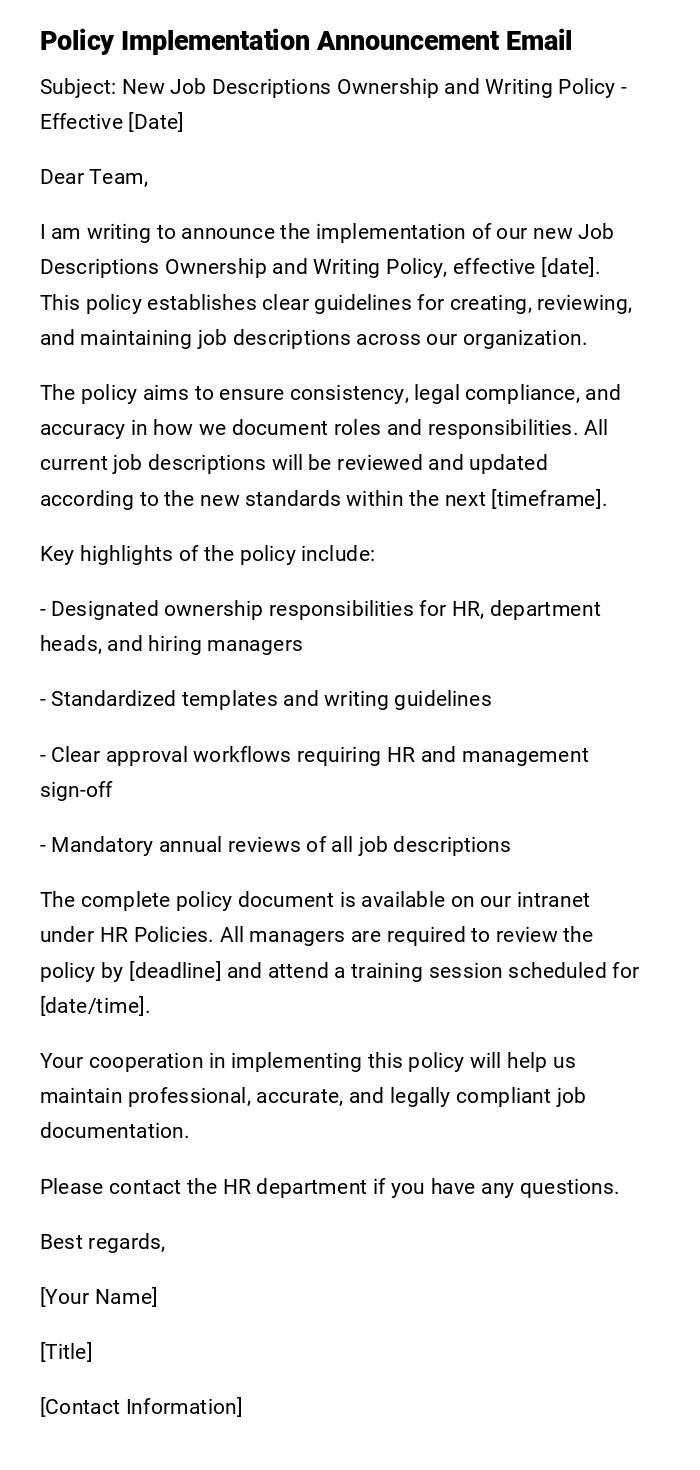
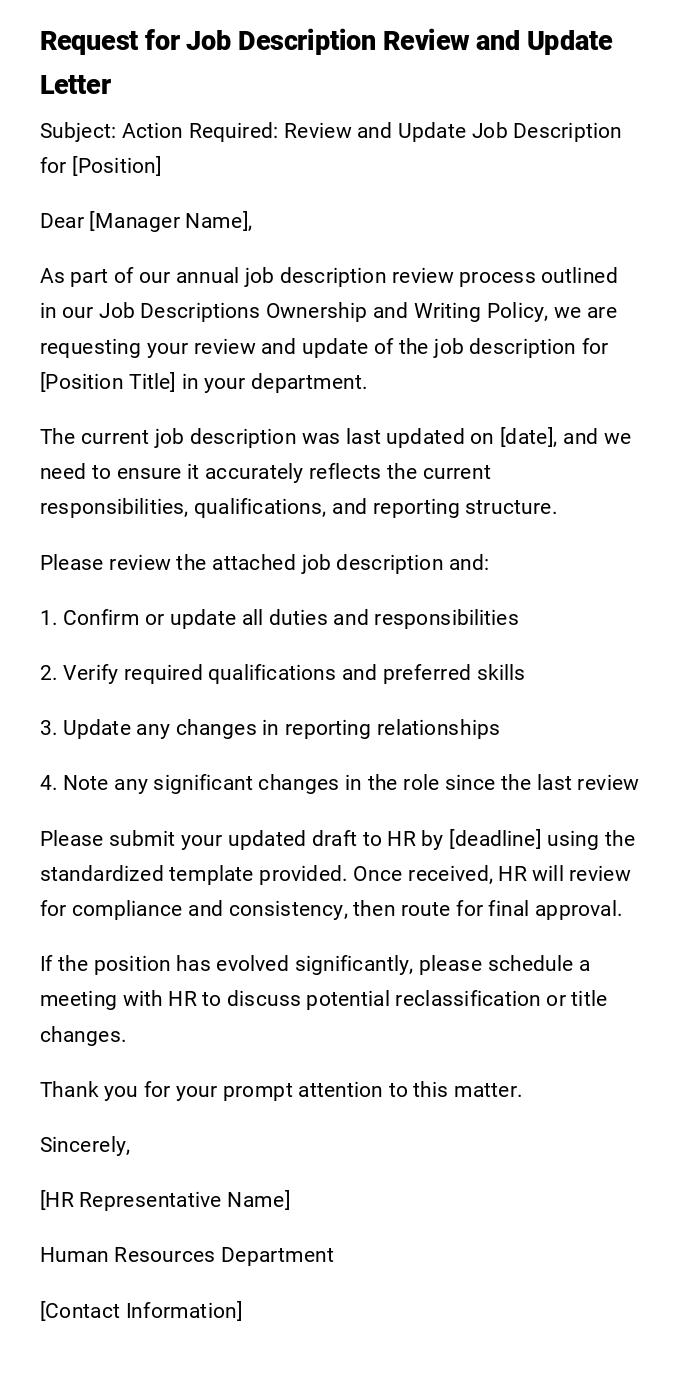
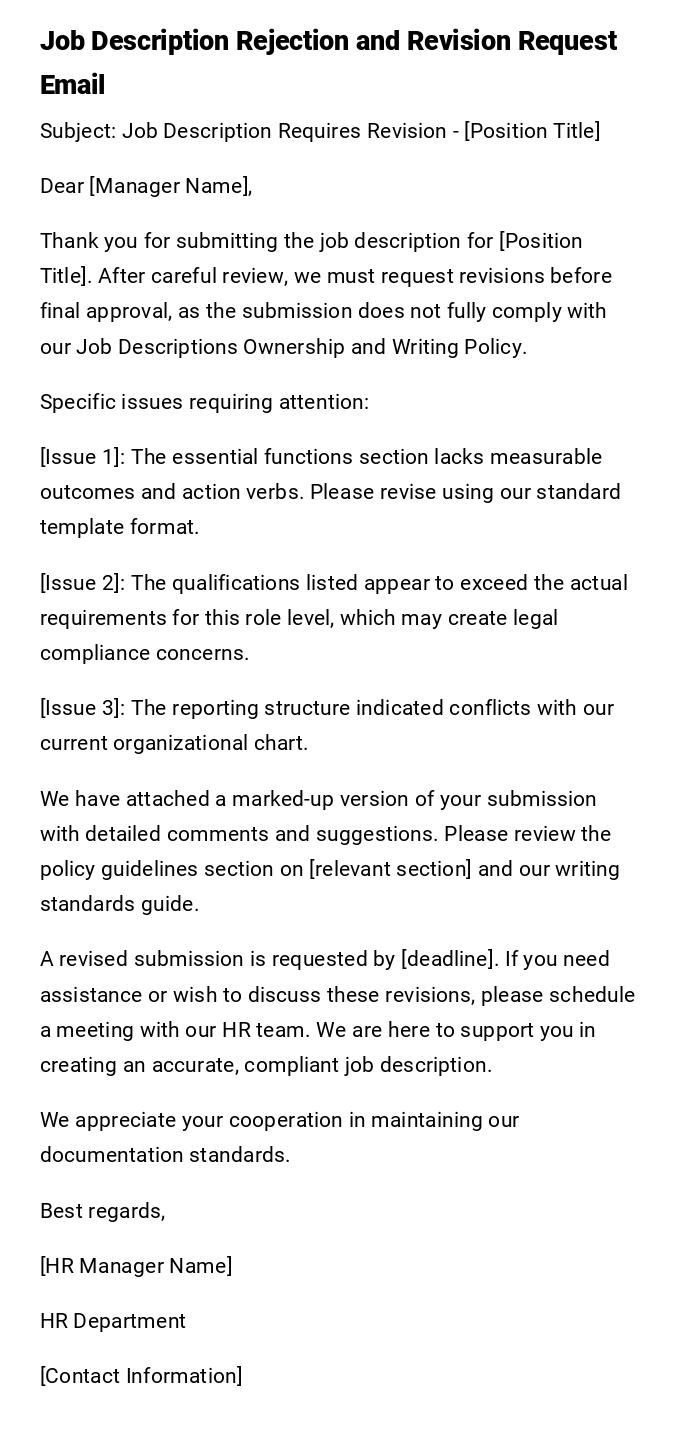
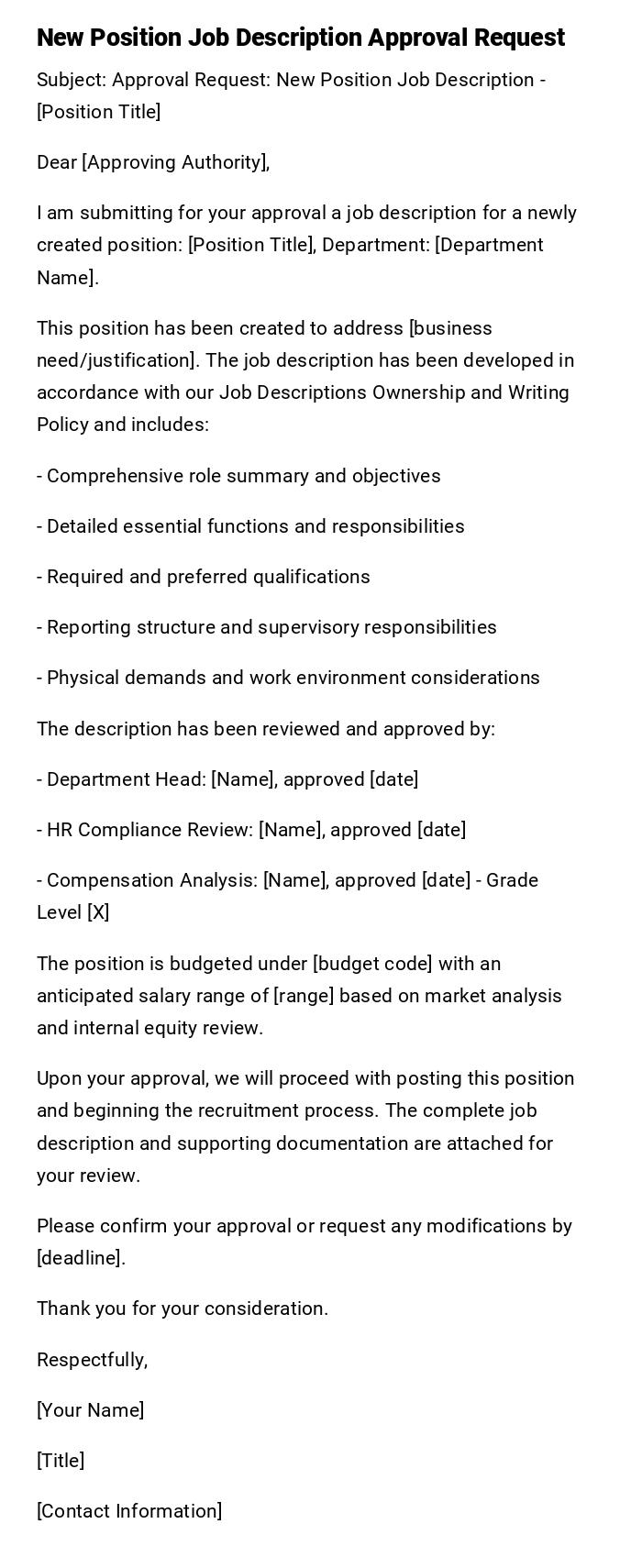
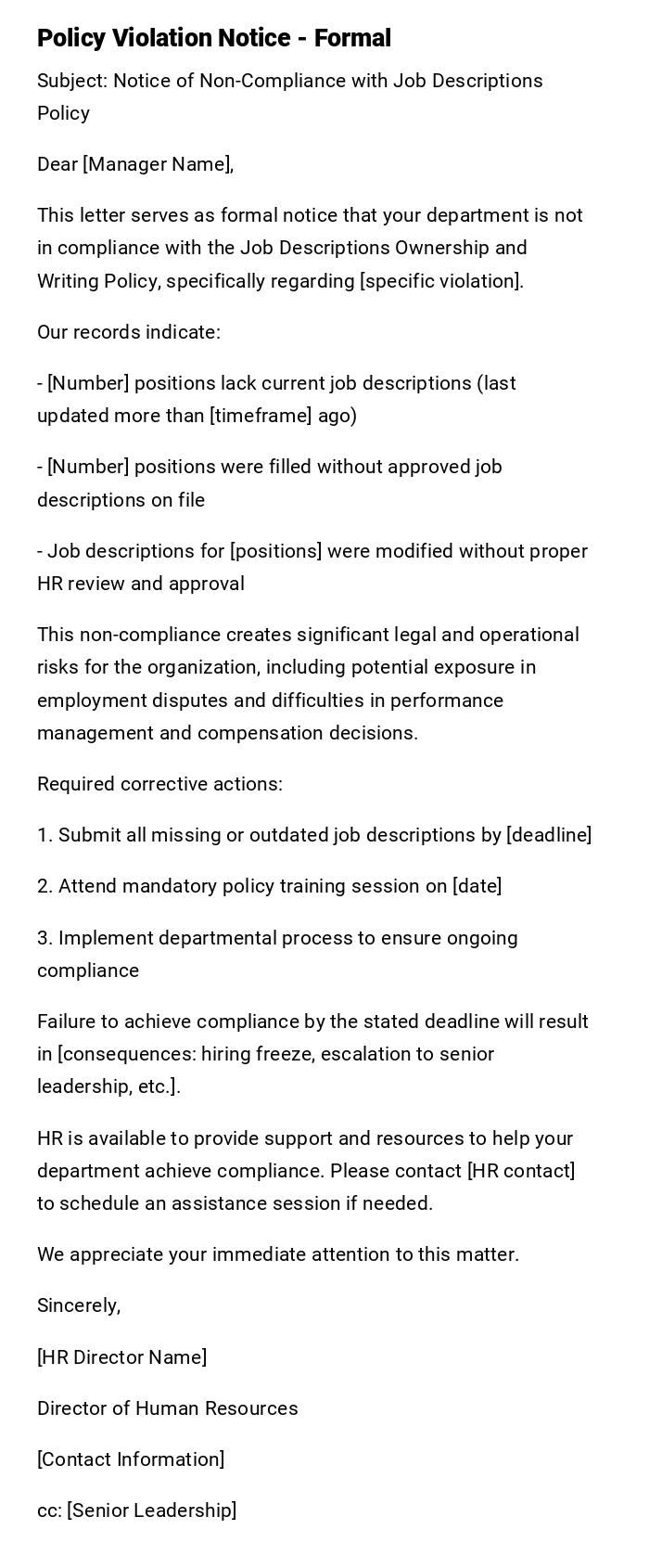
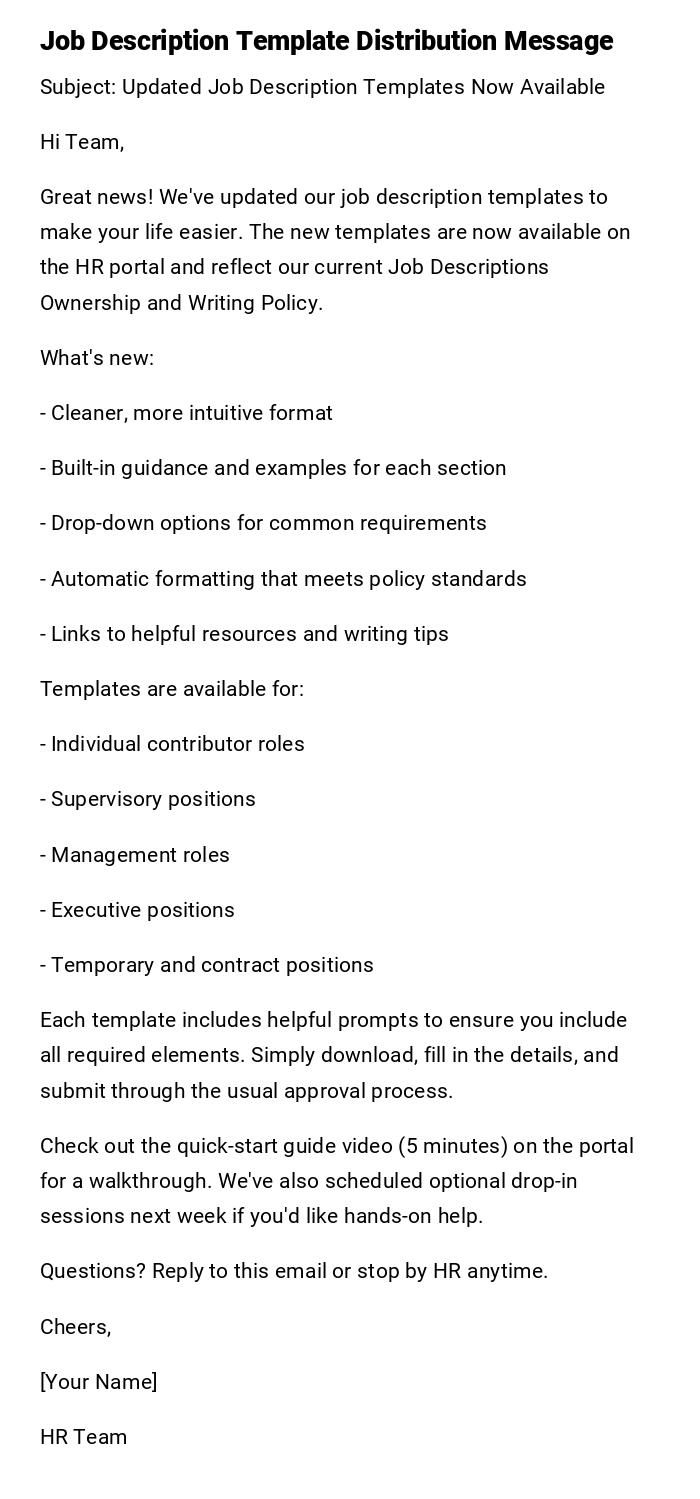
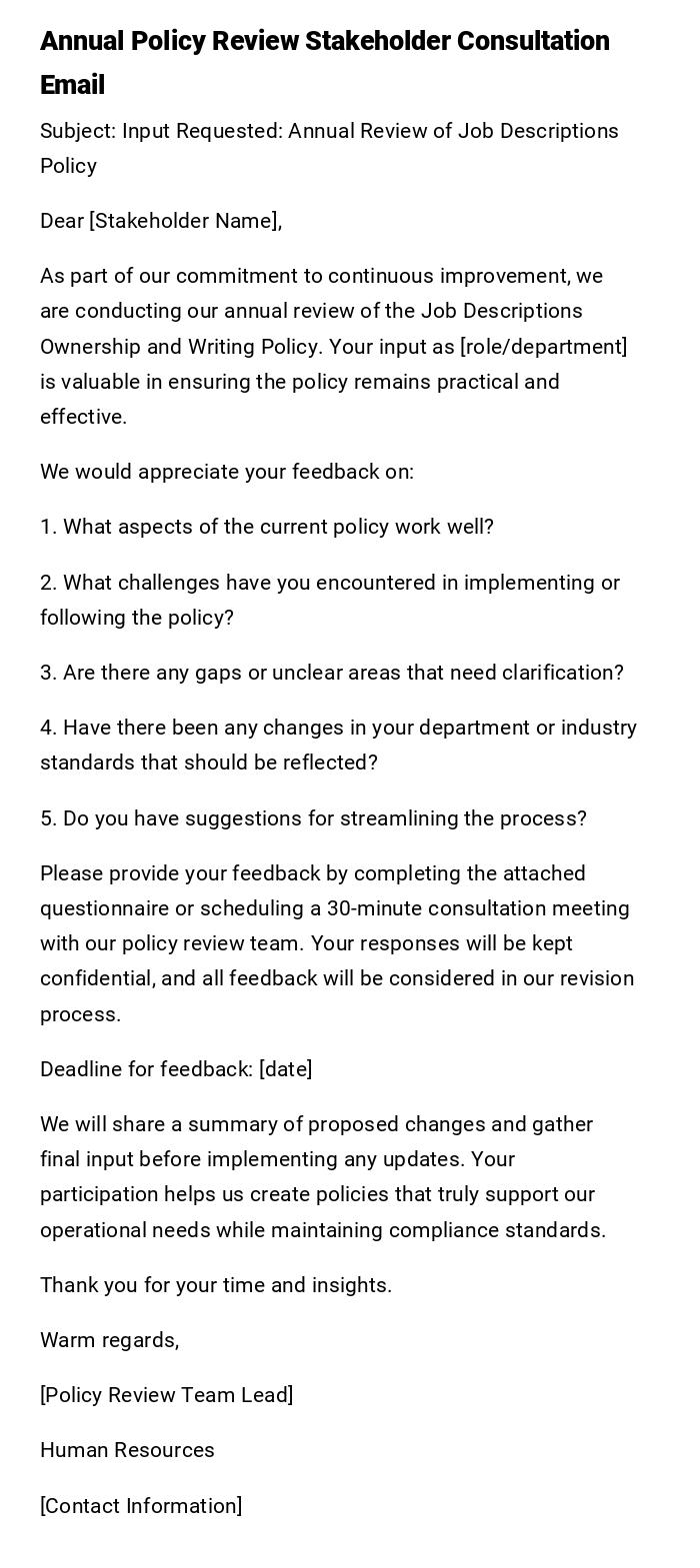
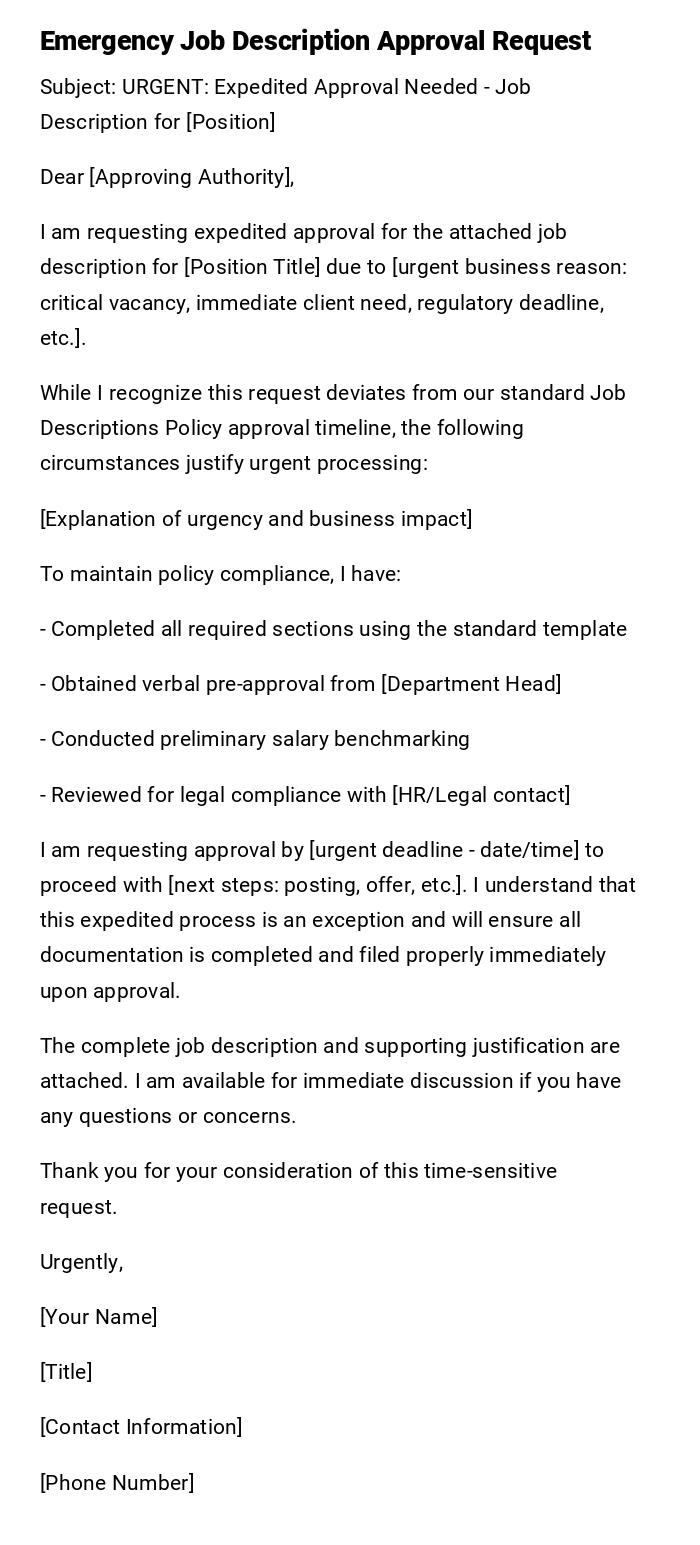

 Download Word Doc
Download Word Doc
 Download PDF
Download PDF